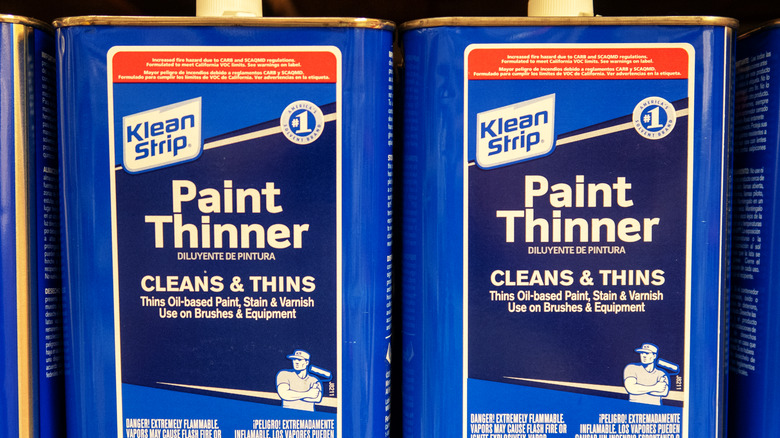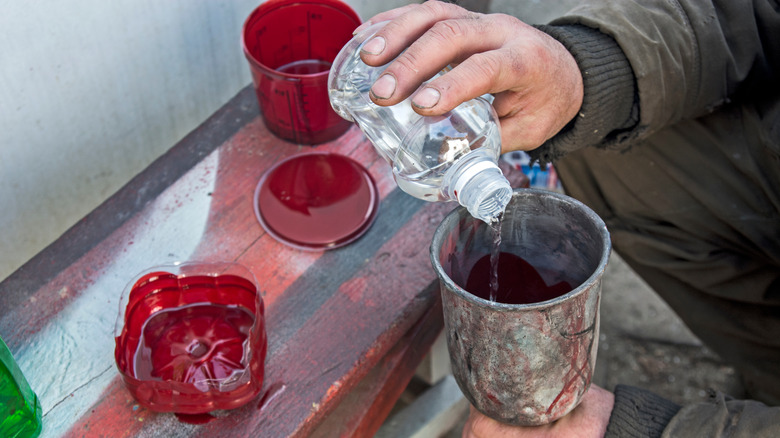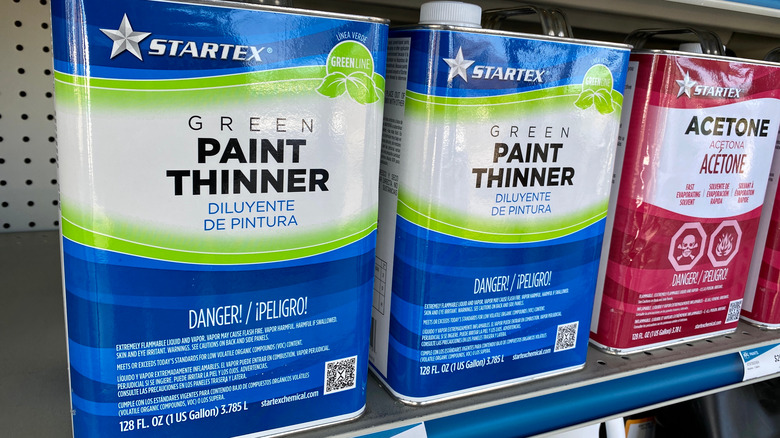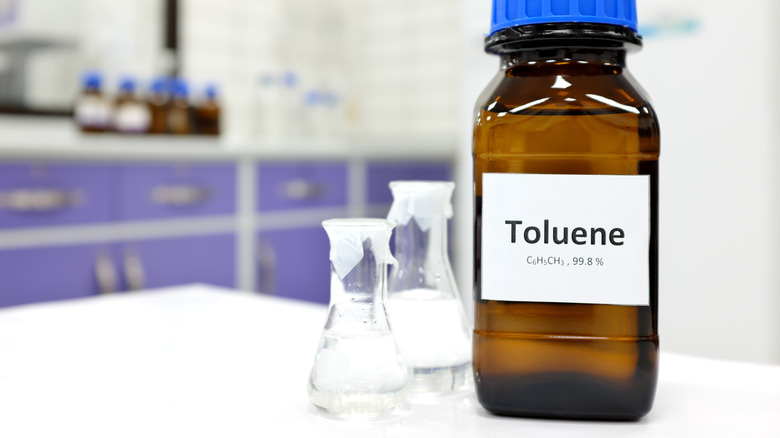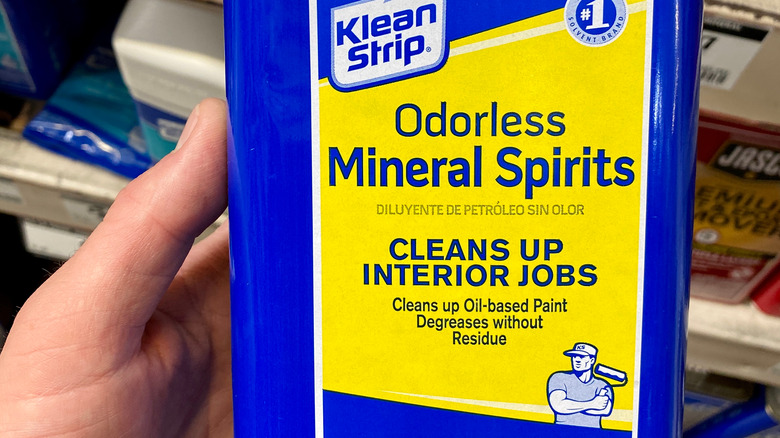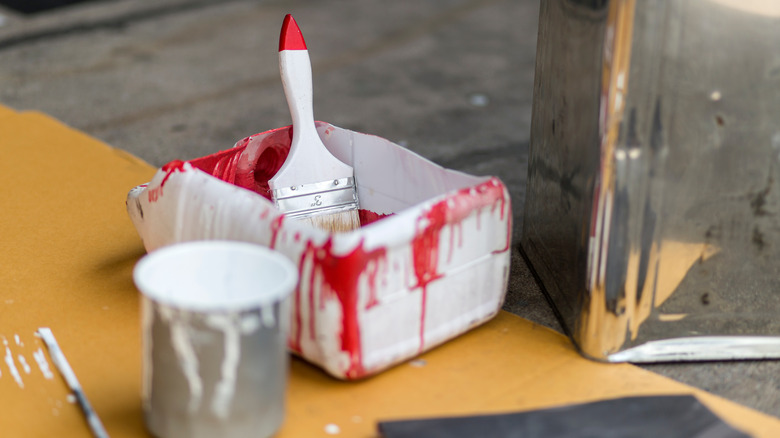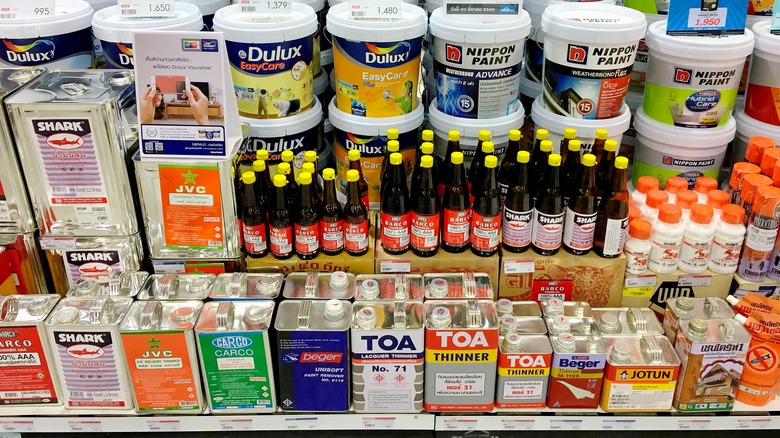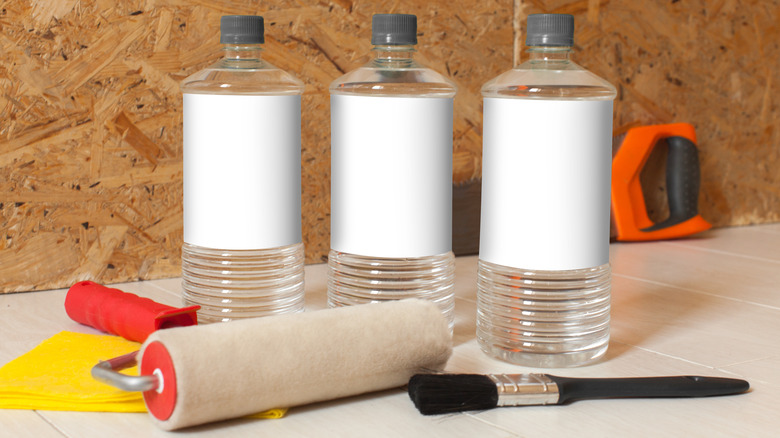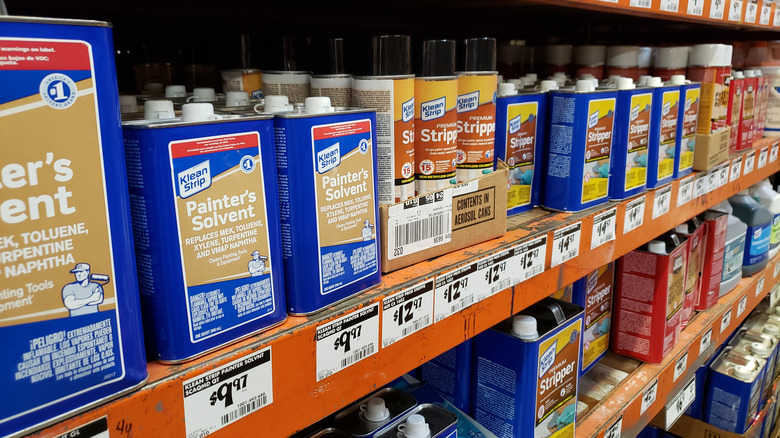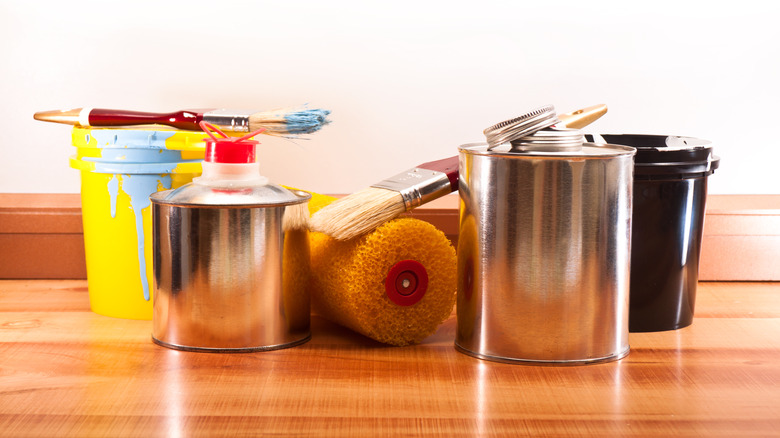Mineral Spirits Vs. Paint Thinner: What's The Difference?
Paint thinner and mineral spirits are two products you will likely come across if you are embarking on a painting job. As the name suggests, paint thinner is commonly used to thin paint, as well as help remove old paint from brushes, rollers, and other paint supplies (via The Spruce). It helps break down oil-based paints, as well as thin out other paints for a more liquid application. Paint thinner is the term for a variety of individual chemicals, as well as chemical compositions, depending on the brand.
Mineral spirits, on the other hand, are made up purely of petroleum distillates, according to The Spruce. Mineral spirits can be used as paint thinner, but that is not its sole purpose. According to Pure Home Improvement, mineral spirits are a versatile and aggressive cleaning product.
It is important to know the differences between these products. For one, the use of mineral spirits versus another chemical or chemical blend when used for paint thinner may produce varied results. These are also dangerous, abrasive, and flammable chemicals, and not knowing their functions and uses can result in a hazardous outcome.
How does the composition differ?
Mineral spirits are composed of 100% petroleum distillates and are made of open chain C7 to C12 hydrocarbons, according to Pure Home Improvement. A major appeal of mineral spirits is that they're often sold in their odorless form. The composition of odorless and regular mineral spirits do differ, though. Highland Woodworking says odorless mineral spirits are an emulsion of petroleum distillates and water. This makes the product less effective, as it is usually up to 60% water. Sometimes acetone is added to odorless formulas for extra strength.
As stated earlier, paint thinner refers to any number of chemicals or chemical compositions. Per CorrosionPedia, paint thinner can include chemicals such as turpentine, isopropyl alcohol, naphtha, acetone, methyl ethyl ketone (butanone), dimethylformamide, glycol ethers, xylene, mineral spirits, and others. Different thinners possess different levels of strength and effectiveness.
What are the differences in cost?
The price comparison between paint thinner and mineral spirits can be a little tricky, since paint thinner refers more to a result than a specific ingredient. According to Family Handyman, however, paint thinner is generally cheaper and more cost efficient than mineral spirits.
At Home Depot, a gallon bottle of mineral spirits is just under $16, and a gallon bottle of paint thinner from the same brand is just under $10 at the time of this publishing. However, the specific chemicals that are used for paint stripping may cost more or less than regular paint strippers, or even more than mineral spirits. In the same brand, a gallon of acetone is currently $23 and a gallon of xylene is $25. The cost of the product largely depends on what you need it for, but paint thinner blends will generally be less expensive.
What are the differences in odor?
Mineral spirits and paint thinners both have very pungent odors. Mineral spirits are sold in odorless varieties, as covered earlier, but even then they aren't entirely odor-free, according to Bob Vila. Mineral spirits generally have a smell similar to kerosene (via Ask Any Difference).
Paint thinner has a notoriously abrasive scent, as it's made up of harsh chemicals. Harsher acetone fumes are common with paint thinners. Regardless of the chemical you are using, make sure to ventilate your space by opening a window, running a fan, and consider wearing a painter's mask to protect your lungs. Keep pets and small children away from areas where you are using paint thinners and/or mineral spirits.
Pros and cons of mineral spirits
There are different uses for mineral spirits and paint thinners, but there are also plenty of projects that could benefit from either product. Each product also has its strengths and drawbacks. According to Bob Vila, mineral spirits are generally less toxic and harmful than other chemical thinners, degreasers, etc. And while they still have an odor, many people find the smell of kerosene more bearable than that of acetone. When used as a paint thinner, it also produces a smoother finish in the final product.
That being said, mineral spirits are a fair bit more expensive than paint thinners, due to the fact that they are refined and pure. Mineral spirits can also cause skin irritation. Lastly, you cannot use mineral spirits with latex paint.
Pros and cons of paint thinner
Paint thinner also has a variety of pros and cons. Bob Vila says that turpentine, for example, can remove dry paint from a surface, whereas mineral spirits can only remove wet paint, making it harder to fix an error after the fact. Turpentine is also much more soluble when compared to mineral spirits. Paint thinner is also cheaper overall.
That being said, paint thinners are much more dangerous than mineral spirits. For one, the fumes are not only off-putting, but dangerous, and the product should only be used in a well-ventilated room or studio. Paint thinner is also very flammable. Rags soaked in paint thinners have been known to spontaneously combust, which happens when the rag produces heat as it dries until it eventually ignites (via Mutual of Enumclaw Insurance). This makes it difficult to safely get rid of leftover paint thinner.
Are mineral spirits safer than paint thinner?
Mineral spirits are much safer than paint thinners. As stated previously, paint thinner has an abrasive, acetone odor that is not only generally upsetting, but can also be dangerous. According to That Painter, it can harm your lungs, nose, throat, and mouth, and can cause permanent damage if your work area is not properly ventilated. It can also cause drowsiness, fainting, and permanent brain damage. And, as mentioned previously, it can result in spontaneous combustion.
Mineral spirits, on the other hand, are less dangerous, but still require precautions. They can irritate the skin if overexposed, so take care to wear gloves and wash your hands when handling it. Mineral spirits are also flammable, but not until around 105 degrees Fahrenheit (via Fireproof Depot). Take care to ventilate when using mineral spirits, too.
How easy is each to DIY?
Mineral spirits and paint thinners can't necessarily be DIYed or made on your own, unless you have certifications to work in a lab and create your own chemical compounds. You can, however, substitute certain chemicals to create similar effects. If you are using mineral spirits to sanitize, clean paint brushes, or to get rid of mold and mildew, House Grail recommends using denatured alcohol. For a last resort substitute for cleaning, they also recommend soap and water.
Paint thinner, on the other hand, is not so much a product as it is a result, and as such there are many substitute resources to create the same effect. House Grail recommends lemon and linseed oil, baby oil, vegetable oil, acetone, and vinegar for thinning oil paints, and water and isopropyl alcohol for thinning latex paints.
When to choose mineral spirits over paint thinner
Mineral spirits and paint thinner serve many of the same purposes, and sometimes mineral spirits are used as paint thinner. Sometimes, one is better than the other for specific projects, though. For example, while both are effective at cleaning paint brushes, Family Handyman recommends paint thinner, as it tends to be cheaper.
According to Bob Vila, mineral spirits are also effective at cleaning up large amounts of paint, oil, tar, and built-up dirt from wood, concrete, and tools, and removing wet paint. Paint thinner, by comparison, is only good for spot treatments, but is the better option for removing dried paint. For artists or painters, this information is important when cleaning painted walls, or touching up painted canvases. Both help thin out oil-based and other water-insoluble paints with similar effectiveness, though some find that mineral spirits produce a smoother result once dry.
Recommended use of each
Generally, paint thinner is great at doing just that — thinning paint. Specifically, water-insoluble paints, such as oil-based formulas. Other uses include cleaning brushes and painting equipment, removing mistake paint, and stripping large sections of paint, according to The Spruce.
Mineral spirits can also be used to clean painting supplies and thin paint. However, according to Bob Vila, it can also be used to degrease car parts, remove large paint spills, clean scuff marks, remove sticker residue, restore wood furniture, and shine garden tools. Whichever you choose, remember to properly ventilate your workspace when using either product, as well as to wear gloves and avoid touching your eyes, nose, or mouth.
